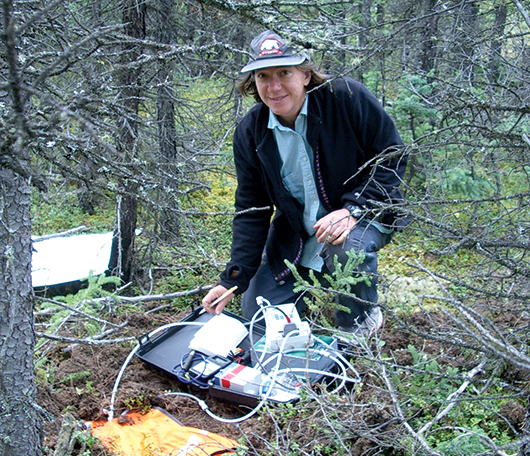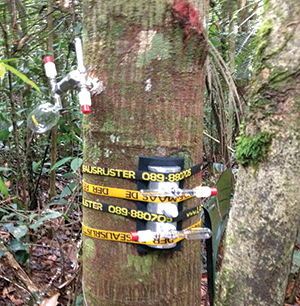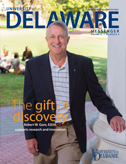
Carbon researcher is in her element
ALUMNI | Having wielded a machete through the Amazon, carbon-dated the Shroud of Turin and discovered 1,000-year-old trees, Susan Trumbore sounds not unlike a real-life Indiana Jones. But instead of searching for historical artifacts, she is on a quest for a different sort of vestige from the past: carbon.
A geologist by training, Trumbore, EO81, studies carbon found in soil and the atmosphere in the context of human activity and climate change. From using radiocarbon dating in new ways to examining how global warming releases carbon from soil, the sixth element on the periodic table has been a common thread through her work.

Trumbore is recognized among the scientific elite, frequently publishing in high-impact journals like Science and Nature and being elected to the National Academy of Sciences. In 2009, she was named a director at the prestigious Max-Planck Institute for Biogeochemistry in Jena, Germany.
“It is like winning the science lottery,” she says. “They basically just give you a budget and a department and tell you to do whatever you want. It’s very hard to turn that down.”
Based from her laboratory in Germany, Trumbore travels the world to study various soils and their interaction with the environment. Much of her fieldwork takes place in Brazil, where she is documenting the amount and age of carbon in tropical forests of the Amazon Basin.
Working her way through thick, humid forests, the smell of decay hanging in the air, she and her colleagues machete their path through the vegetation to dig pits into the forest floor. Their goal is to figure out how long carbon resides in soils and plants and which processes control its release.
Forests are generally seen as carbon “sinks,” storing large amounts of carbon in trees and soil—including carbon dioxide generated from human pollution. Yet Trumbore and her team found that higher temperatures could cause the release of carbon dioxide from forest soils, making global warming an even more serious threat.
In studying these kinds of environmental connections, Trumbore has found other surprises in the forest. Some slow-growing trees in the central Amazon, for example, are very small yet hundreds of years old. Limited sunlight penetrating the tree canopy above may be a factor, but the scientists are taking a closer look.
“We don’t know a lot about the dynamics of growth,” Trumbore says.
Elsewhere in the world, she works with an international team analyzing how climate and underlying geology impact soils in South African savannas. At German field sites, her team is focusing on how land management and biodiversity affect the capacity of soil to hold organic matter over time. And back in the United States, she will teach this January at the University of California, Irvine, where she helped start the Earth system science program and still has a part-time appointment.
“One of the great joys of science is being able to go and see the great variety of soils and ecosystems, but also to work with students from all these different places,” Trumbore says.
With carbon as a common link between many of her projects, the scientific tools used have varied.
As a geology major in what is today UD’s College of Earth, Ocean, and Environment, Trumbore took a geochemistry class on isotopes, or variants of elements, and found the idea of radiometric dating fascinating. She learned what were then cutting-edge techniques in the field, and after graduating in 1981 and enrolling in graduate school at Columbia University, she learned a new method for measuring radiocarbon.
Instead of quantifying radioactive decay, a new mass spectrometry method allowed for measurements using only milligrams, instead of grams, of material. Researchers were able to date things that were previously impossible, such as fabric.
Trumbore took her skills to the Swiss Federal Institute of Technology for a high-profile project: carbon-dating the Shroud of Turin. Given a postage-stamp-sized swatch of the artifact, believed to bear the image of Jesus Christ, she made four subsamples that tested the effect of procedures designed to remove potential contaminants, while two other labs made similar tests in parallel.
“It was very nerve-racking, because it was still being shown that the accelerator method could work with sufficient accuracy,” Trumbore says.
When all three labs found the cloth to be from around 1340 A.D.—not 2,000 years old—the resulting publication in Nature in 1989 made headlines around the world. Since then, this type of scientific technique has become routine.
Nowadays, Trumbore uses carbon isotopes and radioactive tracers, introduced into the environment during nuclear weapons testing in the mid-20th century, to follow carbon through vegetation and soils. The work sheds light on how quickly carbon gets exchanged with the atmosphere.
While her soil science is informed by her geological training, Trumbore notes that much of her work focuses more on life sciences, which she never formally studied.
“Life is surprising, and you have to be ready,” she says. “You go where the interesting questions are and ask what are the questions that interest you.”
Article by Teresa Messmore






